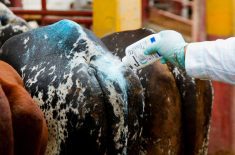Chicago Mercantile Exchange hog futures finished lower on Monday, led by last Friday’s bearish U.S. government quarterly hogs report, traders and analysts said.
Friday’s U.S. Department of Agriculture report showed the U.S. hog herd unexpectedly held steady from the June-August quarter versus a year earlier despite the spread of the porcine epidemic diarrhea virus (PEDv), which is fatal to baby pigs.
Lower cash hog prices and profit taking on the last trading day of the quarter helped send CME hogs to morning bottoms.
Read Also

U.S. livestock: Cattle fall back, hogs continue slide
Chicago cattle futures fell back on Tuesday. Hogs continued to slide. Most-active December live cattle futures closed at 227.775 cents…
Packers have near-term supply needs met after cutting slaughter rates to expand their margins and counter a brief supply shortage.
Monday afternoon cash hog prices in the most-watched Iowa/Minnesota market were $2.91 per hundredweight (cwt) lower than on Friday at $89.80 per cwt, according to USDA (all figures US$).
Jitters about a possible U.S. government shutdown over the budget battle in Washington D.C. sidelined potential futures buyers, traders said.
USDA daily livestock prices and reports will not be available if the agency is forced to furlough some of its employees.
Although USDA’s data would be missed, some traders will likely count on their contacts in the industry for market information, said independent hog futures trader James Burns.
Hog market losses dropped December futures below their 20-day moving average of 87.18 cents. Those declines stirred fund selling, and later speculative bargain hunting.
October hogs finished at 91.975 cents per pound, 0.95 cent lower. December closed 1.5 cents lower at 86.625 cents.
Cattle slip on profit-taking
CME live cattle futures posted modest loses on end-of-quarter profit-taking that broke the market’s eight-day win streak, traders and analysts said.
The belief that futures were too pricy compared with last week’s cash cattle sales, and spillover pressure from Wall Street, kept a lid on live cattle contracts, traders said.
October closed 0.4 cent/lb. lower at 127.85 cents. December finished at 131.975 cents, down 0.1 cent.
Last week, cash cattle in the U.S. Plains moved at $126/cwt, which was $2 higher than the week before, feedlot sources said.
Fewer cattle for sale forced packers to hike bids for supplies, to the detriment of their margins.
Estimated margins for U.S. beef packers on Monday were a negative $17.85 per head, compared with a negative $7.85 on Friday and a negative $1 a week ago, according to HedgersEdge.com.
Tight cattle supplies reduced the flow of fresh beef to retailers, which stabilized the cutout.
USDA data on Monday afternoon showed the wholesale choice beef price, or cutout, at $193.25/cwt, up 62 cents from Friday. Select cuts rose $1.46 to $177.61.
Weak feeder cattle futures pressured the CME October feeder cattle contract.
CME October feeder cattle ended down 0.025 cent/lb., to 164.1 cents.
Lower-priced corn supported other feeder cattle contracts. Cheaper corn can reduce input costs for feedlot operators.
Corn prices at the Chicago Board of Traded slid in response to a larger-than-expected number for corn seen in USDA’s Monday morning quarterly stocks report.
November feeder cattle settled at 165.2 cents, 0.275 cent higher, and January closed up 0.15 cent at 164 cents.
— Theopolis Waters reports on livestock futures markets for Reuters from Chicago.














